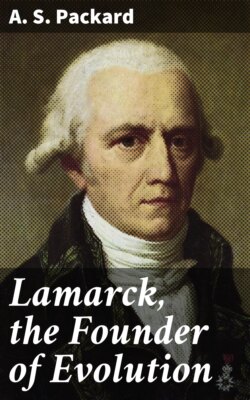Читать книгу Lamarck, the Founder of Evolution - A. S. Packard - Страница 13
На сайте Литреса книга снята с продажи.
FOOTNOTES:
ОглавлениеTable of Contents
[32] Most men of science of the Revolution, like Monge and others, were advanced republicans, and the Chevalier Lamarck, though of noble birth, was perhaps not without sympathy with the ideas which led to the establishment of the republic. It is possible that in his walks and intercourse with Rousseau he may have been inspired with the new notions of liberty and equality first promulgated by that philosopher.
His studies and meditations were probably not interrupted by the events of the Terror. Stevens, in his history of the French Revolution, tells us that Paris was never gayer than in the summer of 1793, and that during the Reign of Terror the restaurants, cafés, and theatres were always full. There were never more theatres open at the same period than then, though no single great play or opera was produced. Meanwhile the great painter David at this time built up a school of art and made that city a centre for art students. Indeed the Revolution was “a grand time for enthusiastic young men,” while people in general lived their ordinary lives. There is little doubt, then, that the savants, except the few who were occupied by their duties as members of the Convention Nationale, worked away quietly at their specialties, each in his own study or laboratory or lecture-room.
[33] Bern. Germ. Étienne, Comte de Lacépède, born in 1756, died in 1825, was elected professor of the zoölogy of “quadrupedes ovipares, reptiles, et poissons,” January 12, 1795 (Records of the Museum). He was the author of works on amphibia, reptiles, and mammals, forming continuations of Buffon’s Histoire Naturelle. He also published Histoire Naturelle des Poissons (1798–1803), Histoire des Cétacés (1804), and Histoire Naturelle de l’Homme (1827), Les Ages de la Nature et Histoire de l’Espèce Humaine, tome 2, 1830.
[34] Perrier, l. c., p. 14.
[35] Fragments Biographiques, p. 214.
[36] Fragments Biographiques, p. 213.
[37] A few years ago, when we formed the plan of writing his life, we wrote to friends in Paris for information as to the exact house in which Lamarck lived, and received the answer that it was unknown; another proof of the neglect and forgetfulness that had followed Lamarck so many years after his death, and which was even manifested before he died. Afterwards Professor Giard kindly wrote that by reference to the procès verbaux of the Assembly, it had been found by Professor Hamy that he had lived in the house of Buffon.
The house is situated at the corner of Rue de Buffon and Rue Geoffroy St. Hilaire. The courtyard facing Rue Geoffroy St. Hilaire bears the number 2 Rue de Buffon, and is in the angle between the Galerie de Zoologie and the Bibliothèque. The edifice is a large four-storied one. Lamarck occupied the second étage, what we should call the third story; it was first occupied by Buffon. His bedroom, where he died, was on the premier étage. It was tenanted by De Quatrefages in his time, and is at present occupied by Professor G. T. Hamy; Professor L. Vaillant living in the first étage, or second story, and Dr. J. Deniker, the bibliothécaire and learned anthropologist, in the third. The second étage was, about fifty years ago (1840–50), renovated for the use of Fremy the chemist, so that the exact room occupied by Lamarck as a study cannot be identified.
This ancient house was originally called La Croix de Fer, and was built about two centuries before the foundation of the Jardin du Roi. It appears from an inspection of the notes on the titles and copies of the original deeds, preserved in the Archives, and kindly shown me by Professor G. T. Hamy, the Archivist of the Museum, that this house was erected in 1468, the deed being dated 1xbre, 1468. The house is referred to as maison ditte La Croix de Fer in deeds of 1684, 1755, and 1768. It was sold by Charles Roger to M. le Compte de Buffon, March 23, 1771. One of the old gardens overlooked by it was called de Jardin de la Croix. It was originally the first structure erected on the south side of the Jardin du Roi.
[38] In the “avertissement” to his Système des Animaux sans Vertèbres (1801), after stating that he had at his disposition the magnificent collection of invertebrate animals of the museum, he refers to his private collection as follows: “Et une autre assez riche que j’ai formée moi-même par près de trente années de recherches,” p. vii. Afterwards he formed another collection of shells named according to his system, and containing a part of the types described in his Histoire Naturelle des Animaux sans Vertèbres and in his minor articles. This collection the government did not acquire, and it is now in the museum at Geneva. The Paris museum, however, possesses a good many of the Lamarckian types, which are on exhibition (Perrier, l. c., p. 20).
[39] Lettre du Ministre des Finances (de Ramel) au Ministre de l’Intérieur (13 pr. an V.). See Perrier, l. c., p. 20.
